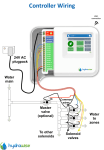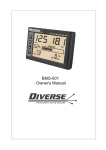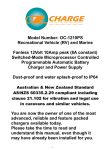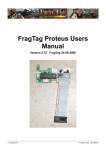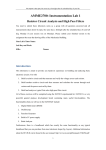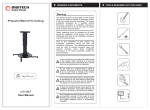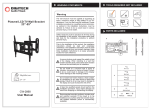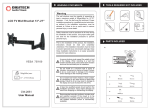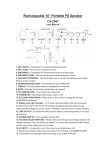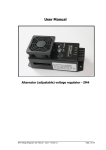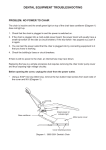Download POWER ADAPTORS OR `PLUG PACKS`
Transcript
Electus Distribution Reference Data Sheet: PLUGPACK.PDF (1) POWER ADAPTORS OR PLUG PACKS Power adaptors or plug packs are very handy devices, providing a compact and convenient source of safe low voltage power derived from the mains. Nowadays many small items of electronic equipment are designed to be operated from these adaptors, either normally or as an alternative to batteries. In most cases theres no problem using this kind of adaptor, because equipment manufacturers usually either include a correctly matching adaptor with the equipment, or make one readily available as an optional extra. However problems can arise if you try to use a different adaptor, perhaps because the correct one has become lost or damaged and theyre no longer available. While its almost always possible to substitute a commonly available adaptor, without upsetting the equipments operation or causing any damage, this does require considerable care and a good understanding of what youre doing. There are a number of different types of adaptor, and also plenty of potential traps for the unwary. If youre not careful you can easily cause expensive damage to your equipment, by connecting it to either the wrong kind of adaptor, or connecting it to the right kind but in the wrong way. In this data sheet well try to give you the knowledge needed to avoid these problems, so you can make use of power adaptors with confidence and success. Adaptor types DC adaptors As mentioned earlier the most common type of adaptor is designed to deliver low voltage DC, as this is what is needed to operate most modern electronic equipment. The simplest and cheapest type of DC adaptor consists of a very small stepdown transformer plus a rectifier and a filter capacitor (Fig.1). The transformer steps the high AC mains voltage down to a much lower AC voltage, while the rectifier and capacitor convert the low voltage AC into reasonably smoothed DC. This type of adaptor is generally available with either fixed nominal output voltage (i.e. 6V, 9V, 10V, 12V or 15V) or with a switch to select one of a number of voltage levels. Theyre also made in a range of sizes, rated to deliver different levels of maximum output current. For example there are nominal 9V adaptors available with current ratings of 100mA, 200mA, 300mA, 500mA or 1A. Similarly there are selectable-voltage adaptors where the maximum current is fixed at say 300mA, but the nominal output voltage can be set to any of six values between 3V and 12V. The main problem with this simple type of DC adaptor is that the actual output voltage tends to vary over a fairly wide range, for different levels of current fed to the load (i.e., your radio, CD player, PDA or whatever). In particular t h e o u t p u t v o l t a g e t e n d s t o rise significantly above the adaptors nominal voltage , for load currents lower than the rated maximum. For example an adaptor rated to provide say 9V at up to 200mA might deliver 11V when the load only draws 130mA, and the voltage may rise even further to 14V or so if the load draws only 50mA. In other words, this type of adaptor is said to have poor voltage regulation . This happens mainly because of the poor performance of the very small stepdown transformer they use, and the modest filter capacitor. As you might expect, the wide variations in output voltage can cause problems when you try to use this type of simple adaptor with many pieces of electronic equipment. For example equipment that doesnt draw much current might overheat or even be damaged, because of the higher voltage that the adaptor applies to it at that lower current level. Or if the current drawn by the equipment tends to vary up and down in operation (which happens with many radios and amplifiers, for example), the resulting variations in the adaptors output The first thing to be aware of is that there are quite a few different types of adaptor. For example most deliver low voltage DC (direct current) like a battery, but a few deliver low voltage AC (alternating current) which is quite different, of course. Even among those which deliver DC, there are quite a few different types. There are many where the DC output voltage is unregulated , and can vary over quite a wide range depending upon how much load current they have to deliver. Then theres the more expensive regulated type, where the output voltage is substantially constant even when the load current varies over a wide range. Theres also special adaptors which are designed not to power electronic equipment directly at all, but to provide the correct current and voltage output characteristics to recharge a particular type of battery. There are other variations, too. Adaptors come in a range of physical sizes, mainly determined by the amount of power theyre designed to deliver. Those intended to deliver quite low power are generally in a small rectangular case which is integrated with the mains plug (i.e., the traditional plug pack), Fig.1: The cheapest DC power while those intended to deliver more power are adaptors are the unregulated type, usually in a larger case with a normal mains with only a transformer, rectifier cord and plug. These inline adaptors may have and filter. But their poor output a permanently attached mains cord, or regulation can cause problems... alternatively a captive three-pin IEC plug to accept a standard universal mains cord. Some adaptors use switch mode circuitry to deliver higher output and regulated DC, as this approach is more efficient than the traditional stepdown transformer and rectifier, allowing them to be smaller and lighter in weight. Clearly, then, its important to pick the correct type of adaptor for your application. Picking the wrong one could be disastrous, so well now look more closely at each of the various types. Electus Distribution Reference Data Sheet: PLUGPACK.PDF (2) Fig.2: One common type of regulated DC adaptor is similar to the simple unregulated type, but has a linear regulator IC added to keep the output constant. A small switch may be added to allow selection of different output voltage levels, as shown above and at left. The unit pictured also has a range of interchangeable output plugs, to suit different equipment. voltage might easily produce distortion or other nasty effects such as varying hum level. If your equipment does draw a fairly steady current, its still possible to use this type of simple unregulated adaptor with it, by carefully checking the equipments load current with its correct supply voltage, and then selecting an adaptor which does produce the right voltage at that current level. Needless to say this can involve a fair amount of testing and experimenting. For example to run a piece of equipment which draws only a small current (say 30mA at 9V), you might end up having to use an adaptor with somewhat lower nominal voltage (say 6V), because its actual output voltage rises to that level with the low drain. Or a similar adjustable-output regulator with its nominal output set to 6V. Of course you may not be prepared to do this sort of experimenting, or may not have the time. Or your equipments current drain may vary so much that a simple unregulated adaptor simply wont be good enough, because its voltage will inevitably vary too widely. In these cases youll need to use the regulated type of adaptor. Regulated adaptors Theyre more complex inside, and hence more expensive, but regulated adaptors are more suitable for powering any equipment which is relatively critical of its supply voltage. Thats because additional circuitry inside this type of adaptor regulates or stabilises the output voltage, holding it very close to the nominal value even when the load current varies over a wide range. So a regulated 9V/1A adaptor will deliver an output voltage of almost exactly 9V whether the load draws a current as low as 30mA or as high as 1A. There are actually two types of regulated DC adaptor. One type is essentially the same basic transformer and rectifier circuit as in a simple unregulated supply, but with additional analog circuitry at the output to regulate the output voltage. Often this is via a fixed or adjustable Fig.3: Whats inside the switch mode type of regulated DC power adaptor. The mains AC is rectified to produce high voltage DC, which is then fed to a very efficient switching DC-DC converter. Feedback allows the converter to monitor and regulate its output voltage. Electus Distribution Reference Data Sheet: PLUGPACK.PDF (3) three-terminal regulator IC, as shown in Fig.2. The other type of regulated supply is the switch mode type, which is essentially a small version of the switch mode power supply used in modern personal computers. Here the mains AC voltage is rectified directly to produce high-voltage DC, which is then used to power a very efficient high frequency DC-DC converter (Fig.3). This runs at 200kHz or so, and uses a very small and light stepdown transformer. Negative feedback is used to regulate the output voltage. Because of its much higher efficiency this type of adaptor tends Fig.4: AC adaptors are essentially just a small to be noticeably smaller and lighter than the analog stepdown transformer in an enlarged plug case. regulated type, for the same output rating. Most adaptors used to power laptop and portable but this generally isnt a problem, because the computers are of the switch mode type, in order to equipment which runs from them almost always includes deliver a regulated output voltage at relatively high its own regulation circuitry. currents. Needless to say, if an AC adaptor is accidentally For many applications, theres no practical difference connected to a piece of equipment designed to run from between the two types of regulated adaptor apart from a DC adaptor, this can cause considerable damage. So the smaller size and weight of the switch mode type. make sure you dont! They both deliver an output voltage thats reliably constant over a wide current range, so simply picking Charging adaptors one with the right output voltage to suit your equipment and its current drain will almost always give These often look very much like standard DC trouble-free eration. adaptors, but theyre really a small battery charger in the same type of compact case. In Incidentally regulated adaptors are many cases theyre still based on a available in both fixed voltage and simple stepdown transformer and selectable-voltage versions, just like rectifier combination, but there may the simpler unregulated type. In this be additional circuitry to vary the case the voltage figures arent just output current level depending on nominal values, though theyre the the terminal voltage of the battery actual voltages you get, so theres theyre designed to charge. usually no need for any measurement or experimenting. Because of the way their voltage/ current performance is optimised for Another point about regulated Fig.5: The output cable of charging particular kinds of battery, adaptors of both types is that their some adaptors is fitted with a this type of adaptor is generally DC output tends to be smoother multi-way star plug, but these quite unsuitable for powering than that from unregulated adaptors. have fairly serious limitations. equipment directly. That is, its purer DC, with less noise and residual AC ripple. So this Charger adaptors designed to suit type of adaptor tends to be better for use with specialised types of battery (such as the lithium-ion equipment that is sensitive to AC ripple on its supply, type) can be quite expensive, because they include like CD and tape players, and desktop sound systems. microcomputer-based circuitry to control charging current levels. AC adaptors The AC type of power adaptor is quite different from any of the DC types. Thats because this type is essentially just an AC stepdown transformer, in a compact protective case (Fig.4). It therefore delivers low voltage AC rather than DC. Needless to say this type of adaptor is only suitable for use with equipment d e s i g n e d t o r u n from lowvoltage AC i.e., having its own inbuilt rectifier and filtering/regulator circuitry. Many home alarm systems are designed to use this type of adaptor, as are some desktop sound systems for PCs. Because they are designed to deliver AC rather than DC, this type of adaptor is by default unregulated. So the rated output voltage is again only a nominal figure; Fig.6: Most modern power adaptors come with a set of interchangeable output plugs, which is a somewhat better way to provide the necessary flexibility. Theyre safer, and also allow you to choose the right polarity. Connector chaos Theres another source of problems when youre trying to find a suitable power adaptor for a piece of electronic equipment: the wide range of different low voltage power connectors in use. These differ in terms of plug type, internal and/or external diameter, insertion length and so on. At least seven main types of power connector are in common use, with quite a few other weird-andwonderful types also used by some manufacturers of particular pieces of equipment such as personal CD and DVD players, laptop computers, camcorders and PDAs. For example Sony is well known for the special subminiature power connectors used on its equipment. Most of these types of power connector are not compatible with each other, which means that in order to use a power adaptor with a particular piece of equipment, it needs to have the correct connector. Which can pose problems... Luckily many adaptors are supplied with either a multi-way star plug on the end of the output cable (Fig.5), or a range of interchangeable plugs (Fig.6). Either approach generally allows you to use the right plug, providing the equipment uses one of the more common Electus Distribution Reference Data Sheet: PLUGPACK.PDF (4) The seven types of low voltage power input plug in most common use. There are many others, though... connectors. However the interchangeable plug system is safer and more elegant, as the star plug system leaves the unused plugs exposed but still connected to the adaptors output. The interchangeable plug system also allows you to obtain additional plugs to suit equipment with the more specialised types of power connector. Jaycar Electronics can supply the special plugs necessary to use many of its adaptors with some of the Sony equipment, for example. Fig.7: Many pieces of electronic equipment designed to operate from a DC power adaptor have the correct polarity indicated near the inlet socket, as shown at left. Watch polarity! With DC power adaptors, theres another source of problems: connector polarity. Unfortunately theres no universal standard when it comes to the way electronic equipment designers wire up their DC power connectors some use the centre pin or plug tip for the positive polarity, while others use the outer barrel or sleeve. So even when you find the correct DC power plug for a piece of equipment, its still important to make sure that its connected to the adaptor output cable with the correct polarity. Connecting the DC power to the equipment the wrong way around will generally stop it from working, and could easily cause expensive damage. How do you find the correct polarity? Often its marked on the equipment case, alongside the power connector (Fig.7). Failing this, you may find it specified in the equipments user manual. In extreme cases you may have to open the equipment and check the connections with a multimeter or DMM. With DC power adaptors which use the interchangeable plug system, the plugs are usually capable of being connected to the adaptor cable either way around. This makes it very easy to set the plug for the correct polarity. However if you use an adaptor which only comes with a single fixed plug, and its polarity turns out to be wrong for your equipment (Murphys Law strikes again!), youll probably have to cut the plug off the cable and fit another plug with the correct polarity. Note that polarity normally isnt a problem with AC adaptors, because their output isnt polarised anyway. In fact some AC adaptors are not supplied with an output plug at all just bared wires on the end of the lead. (Copyright © Electus Distribution, 2001) Power Adaptors stocked by Electus Distribution A very wide range of DC and AC power adaptors are stocked by Electus Distribution stores and authorised dealers. All are approved for use in Australia. Many come complete with seven interchangeable output plugs, to make it easy for you to select the correct plug and polarity. Heres a quick rundown on the range available and their catalogue numbers: Unregulated DC Adaptors 9V DC at 150mA MP-3003 9V DC at 500mA MP-3007 9V DC at 850mA MP-3009 9V DC at 1A MP-3008 10V DC at 850mA MP-3004 (limited quantity) 10V DC at 1.2A MP-3005 (limited quantity) 12V DC at 150mA MP-3002 12V DC at 450mA MP-3006 12V DC at 1A MP-3015 12V DC at 2A (Inline type) MP-3210 24V DC at 500mA MP-3029 3-12V DC at 300mA MP-3010 3-12V DC at 500mA MP-3012 3-12V DC at 1A MP-3016 13.5V DC at 1.8A (Inline type) MP-3212 13.8V DC at 2A (Inline type) MP-3018 Regulated DC Adaptors 3-7V DC at 2.5-1.9A (Switchmode) MP-3131 3-12V DC at 500mA MP-3030 3-12V DC at 1A (Switchmode) MP-3130 3-12V DC at 1.25A (Switchmode) MP-3031 3-12V DC at 1.5A (Six o/p voltages) MP-3035 3-13.8V at 2A (Inline type) MP 3036 5V DC at 2A 5V DC at 2.5A 6V DC at 1.66A 6V DC at 2A 9V DC at 1A 9-24V DC at 1.5-1A 12V DC at 300mA 12/15/18V at 800mA 12V DC at 1A 12V DC at 1A 12V DC at 1.25A 12V DC at 2A 12V DC at 4A 15V DC at 1.5A 18V DC at 1.2A 24V DC at 1A 24V DC at 2A AC Adaptors 9V AC at 1A 10V AC at 1A 12V AC at 500mA 12V AC at 1A 16V AC at 1.25A 17V AC at 1.25A 2 x 11.5V AC at 1.25A (Inline, switch mode) MP-3230 (Switchmode) MP-3140 (Inline, switch mode) MP-3232 (Switchmode) MP-3141 (Switchmode) MP-3136 (Switchmode) MP-3420 MP-3011 (for CCD cameras) (Inline type) MP-3034 (Inline type) MP-3033 (Switchmode) MP-3137 (Switchmode) MP-3220 (Inline type) MP-3017 (Inline, switchmode) MP-3240 (Switchmode) MP-3423 (Switchmode) MP-3424 (Inline type) MP-3037 (Inline, switch mode) MP-3244 MP-3027 MP-3025 MP-3020 MP-3026 (For home alarms) MP-3021 (For home alarms) MP-3022 (Inline type) MP-3055 For more information, please refer to the latest Electus Distribution Catalogue or visit www.electus distribution.com.au




